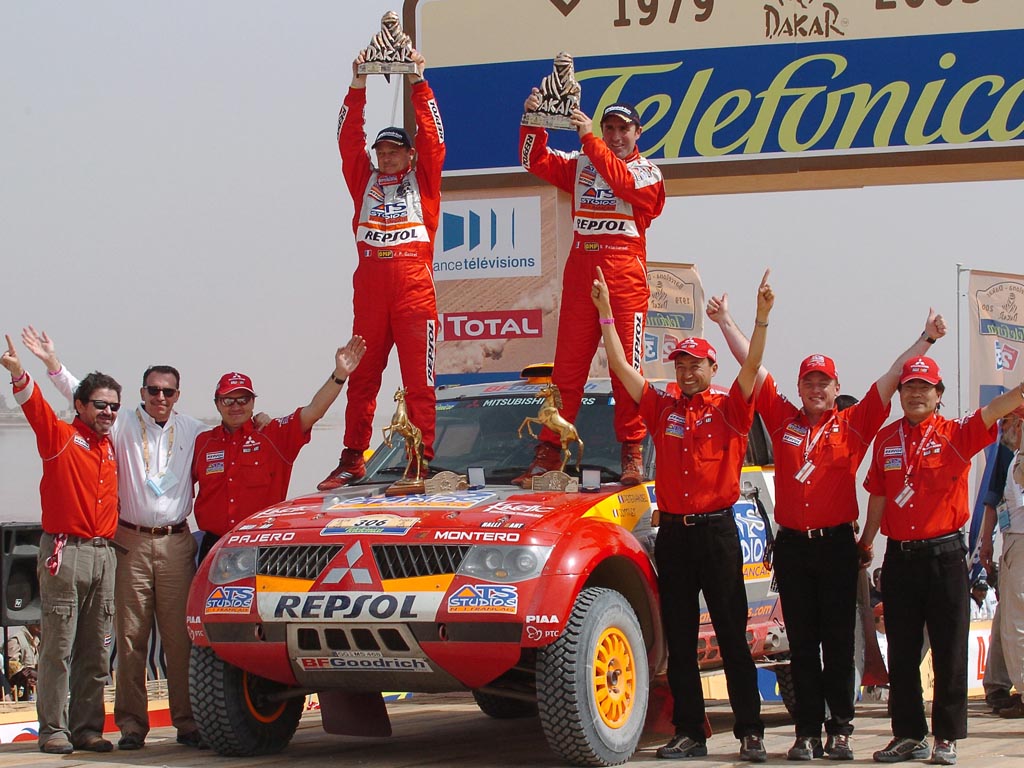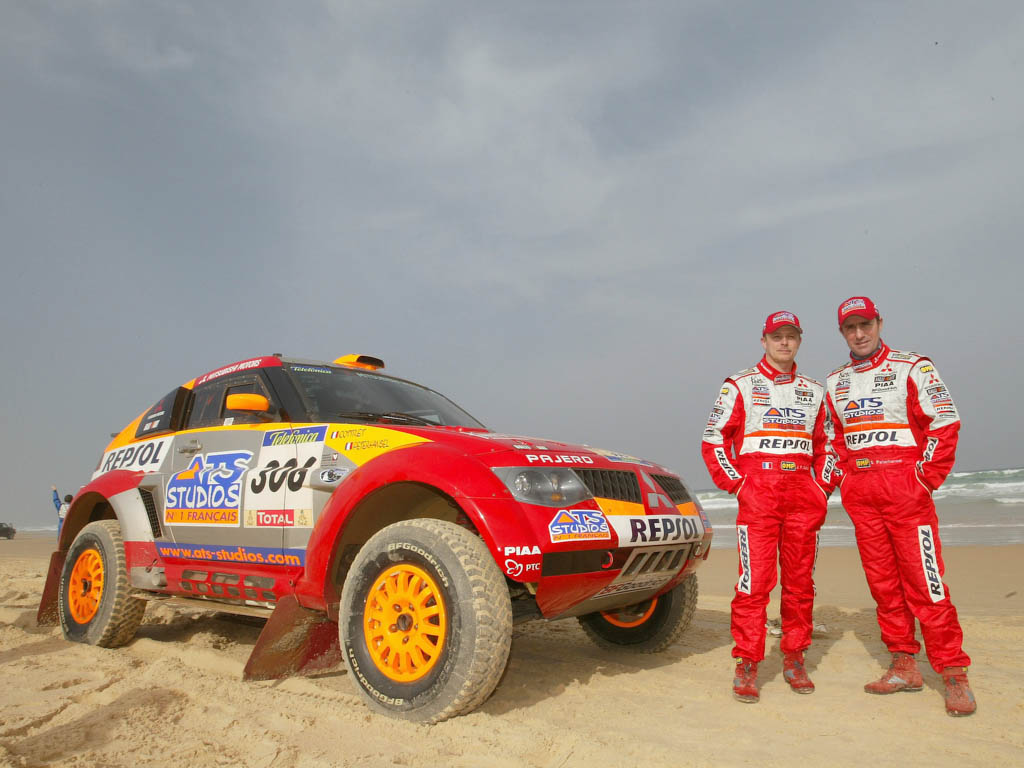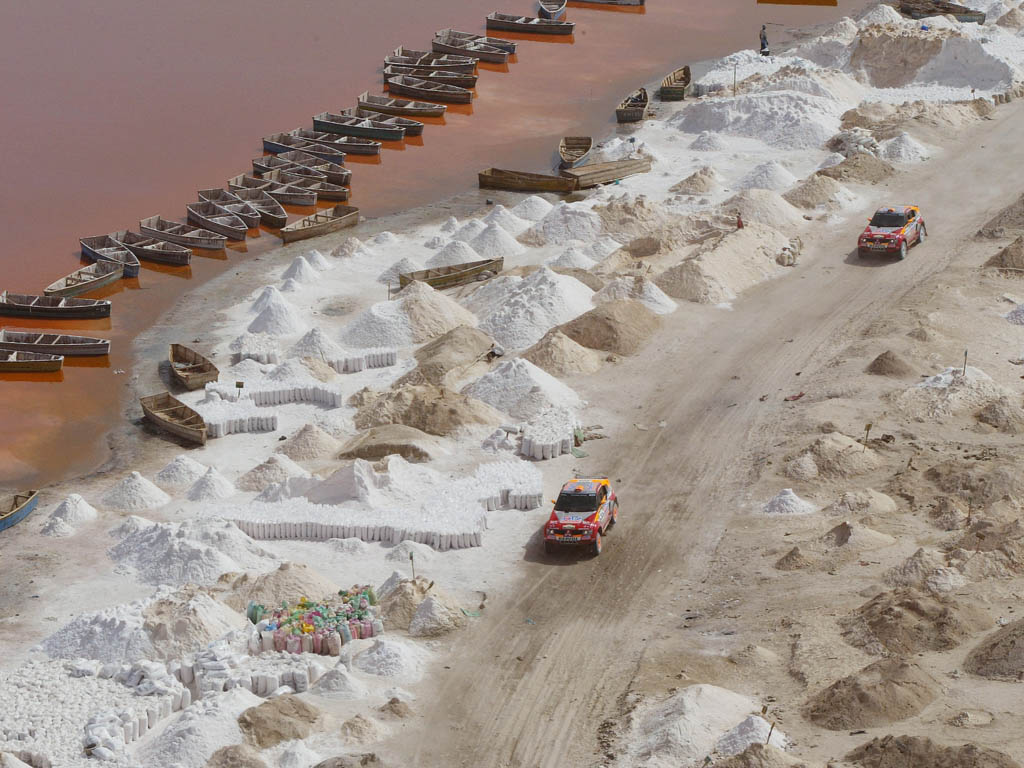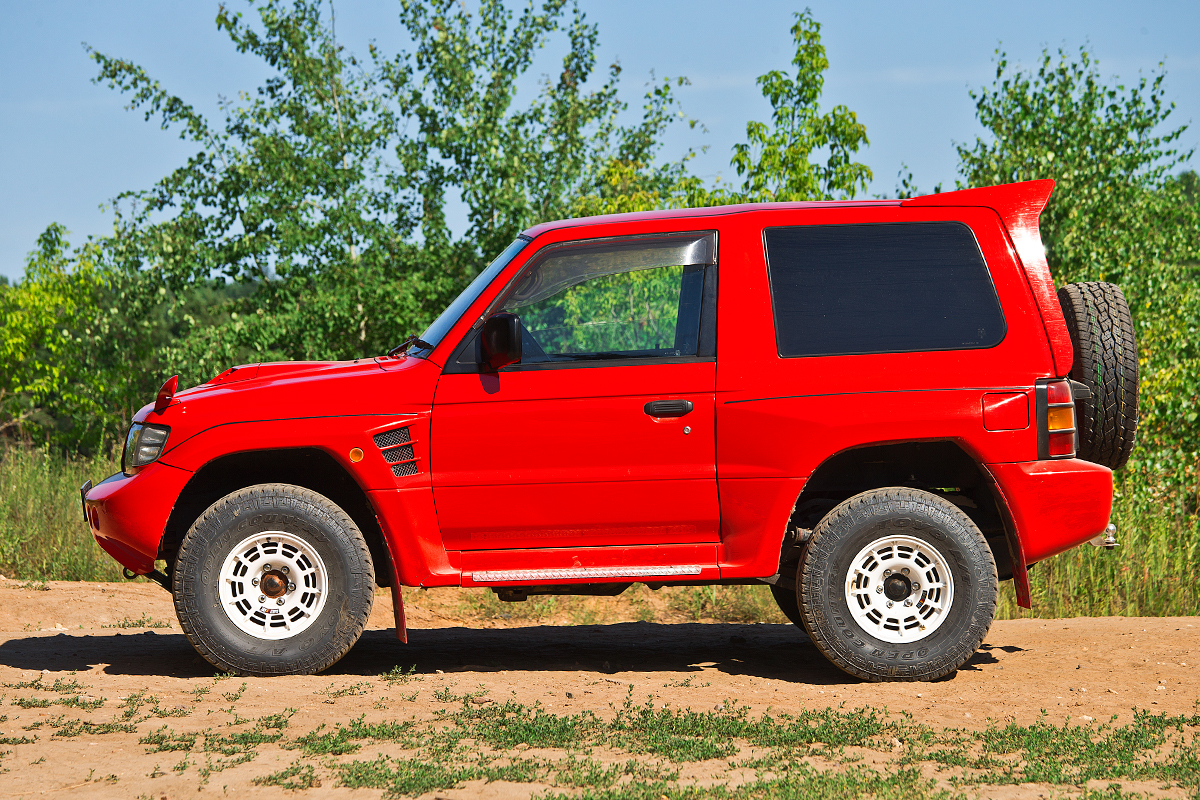2005 Mitsubishi Pajero/Montero Evolution
DAKAR, Senegal – The Mitsubishi Motors team won the Dakar Rally for a record-breaking 10th time, when Frenchman Stephane Peterhansel and codriver Jean-Paul Cottret steered their Mitsubishi Pajero/Montero Evolution to victory at Lac Rose in Senegal.
Mitsubishi’s long experience of off-road racing experience came to the forefront, when the Japanese manufacturer clinched a fifth successive victory in the world’s most difficult off-road rally.
Peterhansel’s team mate Luc Alphand and co-driver Gilles Picard made it an emphatic 1- 2 for the Mitsubishi Motors team by taking the runner-up position in their Mitsubishi Pajero/Montero Evolution. In the 27-year history of the world’s most famous off-road rally no manufacturer of cars, bikes and trucks can match the Japanese company’s winning record.
Mitsubishi’s Peterhansel took the lead as the event headed across the wastelands of Mauritania and won from the front over the remaining special stages through Mali and Sénegal. Team mate Alphand shadowed him to the finish on his debut with the Mitsubishi team and Spaniard Joan Roma â the winner last year on a motorcycle – finished sixth overall in the third Mitsubishi Pajero/Montero Evolution.
The event began in Barcelona on New Year’s Eve and took place over 15 timed special stages in five countries. Mitsubishi won five timed sections, with Peterhansel winning four and Alphand taking the fastest time through the Tidjikja to Atar section.
Overall final classification after SS16:
1. Stephane Peterhansel /Jean-Paul Cottret – Mitsubishi Pajero/Montero Evolution – 52h 31m 39s 2. Luc Alphand /Gilles Picard – Mitsubishi Pajero/Montero – Evolution 52h 58m 53s 3. Jutta Kleinschmidt /Fabrizia Pons – Volkswagen Touareg – 55h 53m 39s 4. Giniel de Villiers /Jean-Marie Lurquin – Nissan Pick-Up – 56h 34m 15s 5. Bruno Saby /Michel Perin – Volkswagen Touareg – 61h 15m 53s 6. Joan Roma /Henri Magne – Mitsubishi Pajero/Montero – 61h 51m 16s 7. Carlos Sousa /Thierry Delli-Zotti – Nissan Pick-Up – 62h 34m 08s 8. Thierry Magnaldi / Jean-Paul Forthomme – Honda Buggy – 63h 35m 23s
Story by Mitsubishi Motor Company

In Detail
| submitted by | Richard Owen |
| engine | Mivec 6-cylinder w/Dry Sump Lubrication |
| valvetrain | DOHC 4 Valves per Cyl |
| fuel feed | ECI multi-point fuel injection |
| displacement | 3997 cc / 243.9 in³ |
| power | 201.3 kw / 270 bhp @ 5500 rpm |
| specific output | 67.55 bhp per litre |
| bhp/weight | 147.95 bhp per tonne |
| body / frame | Steel Honeycomb & Carbon Fibre Body over Multi-Tubular Frame |
| driven wheels | Full Time 4WD w/Mechanical Centre Diff Lock, Xtrac Self-Locking Differentials |
| front tires | BF Goodrich 235/85 – 16 |
| rear tires | BF Goodrich 235/85 – 16 |
| front brakes | Ventilated Brembro Discs w/6-Piston Calipers |
| f brake size | mm / in |
| rear brakes | Ventilated Brembro Discs w/6-Piston Calipers |
| r brake size | mm / in |
| front wheels | F 40.6 x 17.8 cm / 16 x 7 in |
| rear wheels | R 40.6 x 17.8 cm / 16 x 7 in |
| steering | Power Assisted Rack & Pinion |
| f suspension | Double Wishbones w/Coil Springs, Twin Adjustable Shocks |
| r suspension | Double Wishbones w/Coil Springs, Twin Adjustable Shocks |
| curb weight | 1825 kg / 4023 lbs |
| wheelbase | 2775 mm / 109.3 in |
| front track | 1750 mm / 68.9 in |
| rear track | 1736 mm / 68.3 in |
| length | 4222 mm / 166.2 in |
| width | 1978 mm / 77.9 in |
| transmission | 6-speed Ricardo-Type, Sequential Shift |
| gear ratios | :1 |
Mitsubishi pajero evolution 2005
Page 1 of 1
The Mitsubishi Pajero/Montero Evolution was developed from the Super Production car regulations that came into force from 2002. The original design was the brainchild of Olivier Boulay, the former Head of Design at Mitsubishi Motors. The car was based upon the Mitsubishi Pajero/Montero Evolution and Evo 2+2 concept cars and, like all Super Production class models, was limited to a maximum width of 2000 mm and a maximum wheel travel of 250 mm.
The base model was launched at Frankfurt and a refined version was shown at the Geneva Motor Show in March 2002. The motor sport program began in June 2002, in conjunction with MMSP’s Team Director Dominique Serieys and Technical Director Thierry Viardot. The prototype was tested extensively in the wind tunnel. The original Pajero/Montero Evolution MPR10 (MPR standing for Mitsubishi’s factory code name for each model) complied fully with the new regulations. Mitsubishi introduced several modifications to the original Mitsubishi Pajero/Montero Evolution after a detailed test session in Morocco in July 2003.
The major development was the successful transition from a 3.5-litre V6 engine to a 4.0-litre V6 unit. FIA Cross-Country technical regulations allowed engine capacity increases in a minimum of 500 cc increments. The power plant was built and developed in Japan. It was used for the first time during the two-week test in Morocco and powered the factory cars during the 2003 UAE Desert Challenge. Modifications were also made to the suspension set-up and these were put into practice in the UAE Desert Challenge in 2003. MMSP used Brembo brakes, a 500-liter fuel tank was retained, but the minimum weight was extended from 1750 kgs to 1825 kgs as per the FIA technical regulations. The interior roll cage was reinforced around the windscreen and roof areas.
Torque and throttle response was improved considerably and maximum torque increased from 36KG-M to 43 kg/m at 3500 rpm — a 19% improvement. The original Pajero/Montero Evolution engine was lowered by 100 mm and placed 300 mm back for a lower center of gravity to optimise weight distribution. Mitsubishi retained a six-speed sequential gearbox, although a new Kinetic and hydraulic anti-roll bar system was tested extensively in Morocco and used for the first time during the 2003 UAE Desert Challenge.
But Mitsubishi knew that to remain competitive against improving competition, then the MPR10 would need to be further developed and improved. The MPR11 was the result of many months hard work by the team at Pont-de-Vaux and it made its competition debut in the hands of Stéphane Peterhansel and Jean-Paul Cottret during the 2004 UAE Desert Challenge. Team mates Hiroshi Masuoka and Andreas Schulz used the existing MPR10 in Dubai to enable MMSP technicians and engineers to make a comparison between the two cars in adverse conditions.
The new MPR11 offered increased torque, especially at lower engine speeds, although it delivered a similar power output to the MPR10. Mitsubishi carried out exhaustive tests in Morocco with various suspension settings and there were subtle improvements to the suspension. The MPR11 benefited from improved weight distribution and had a lower center of gravity to improve handling, cornering and road holding. Peterhansel and team mate Luc Alphand went on to take first and second overall in the 2005 Dakar Rally with the MPR11 to retain the Pajero/Montero Evolution’s unbeaten record on the Dakar Rally.
But Mitsubishi Motors team management knew that to stand still in terms of car development was asking for trouble and work had began even before the 2005 Dakar Rally on a revised MPR12 version of the all-conquering car. Components were tested on events during the course of the season and Mitsubishi again utilised two rigorous test sessions in Morocco in June 2005 and September 2005 to ensure that the changes and revisions to the car were worthwhile.
«The plan was to make sure that every component on the Mitsubishi Pajero/Montero Evolution was capable of completing an entire Dakar Rally,» admitted Technical Director Thierry Viardot. «That is not to say that we intend to use parts for the entire race. There are many parts which will be replaced as the need requires and on the rest day, but we wanted to make sure that MPR12 was fully reliable.»
Viardot admits that the extra weight of a full tank of fuel can be critical. «A full tank of 500 litres weighs around 400 kgs and that is a lot of extra weight to carry at the start of a day. FIA regulations state that a car in this category must have a fuel range of 800 kms. Weight distribution is so important with this car. With the fuel tank in the back and the engine in the front, a 50:50 weight distribution is arrived at with around 250 liters of fuel in the car.
«We have completely revised components such as the differentials and the dampers. These suspension parts can experience staggering temperatures of up to 200 degrees Centigrade over terrain like camel grass. The new differentials have the same settings as the older ones, but have been designed for reliability, We have spent many hours working on damper and suspension settings and fine tuning what we have.»
An adjustable engine inlet port has been replaced by a fixed inlet port and the team has been forced to adapt the damper settings with the abolition of the Kinetic or hydraulic anti-roll bar system. Magnesium has been replaced by aluminium as a base metal for the wheels, although Viardot admits that each aluminium wheel weighs around five kilograms more than its magnesium predecessor.
Work has been carried out on engine performance and torque characteristics of the engine and Viardot stresses that individual set-ups have now been devised for differing road and stage conditions — be it hot twisty summer stages in Spain where the brakes are crucial, cool Dakar desert stages in Mauritania or the baking heat of the dunes of the United Arab Emirates, where engine and transmission cooling is critical.
Page 1 of 1
Всемогущий? Каков на самом деле Mitsubishi Pajero Evolution
Владимир Мельников
Pajero больше нет. Словно состарившаяся звезда эстрады, он дал с десяток прощальных туров, то есть финальных партий в особых комплектациях, — и в этом году покинул конвейер окончательно. А ведь это был по-настоящему уникальный автомобиль, шасси которого напрямую наследовало знаменитой трехдверке Pajero Evolution, по сути дорожной версии ралли-рейдовых внедорожников. Вы тоже этого не знали?
Он выглядит сногсшибательно — если Lancer Evo можно спутать с обычным седанчиком, то такой Pajero точно никто не примет за простой внедорожник второго поколения. Широченные арки, шрамы воздуховодов и бейсболка-крыша, развернутая назад огромным козырьком спойлера. Зверюга! В тестах того времени эту машину даже называли убийцей спорткаров: ее динамика поражала. Шутка ли, восемь секунд до «сотни» у полноценного вездехода с реальным дорожным просветом в 24 сантиметра! На дворе, напомню, 1997 год. Первый Porsche Cayenne появится через пять лет, а самый быстрый G-ваген называется G36 AMG и набирает «сотню» за 9,6 с. Конечно, еще в 1992-м был представлен сумасбродный GMC Typhoon, который достигал заветной отметки меньше чем за шесть секунд. Но он совершенно лишился внедорожных качеств. А вот Pajero в версии Evolution, наоборот, их только приобрел.
Ведь суть его появления — это легитимизация независимых подвесок для ралли-рейдовых Mitsubishi «серийной» категории Т2. Чтобы использовать в спорте эти хитросплетения рычагов, необходимо было выпустить 2500 дорожных автомобилей с такой же конструкцией шасси.
Поэтому, как бы ни была притягательна внешность, как бы ни манила в путь V-образная «шестерка» 3.5 мощностью 280 л.с., сначала надо разобраться во всем на подъемнике.
Напомню, как выглядит снизу обычный Mitsubishi Pajero второго поколения. Прежде всего это рамный автомобиль, спереди у него двойные поперечные рычаги и торсионы, а сзади жесткая балка моста. Что от этого сохранил Pajero Evolution? Только раму! Шасси полностью оригинальное — с пружинами спереди и многорычажной схемой сзади. Вот только где-то я уже видел такой нижний поперечный рычаг и длинную продольную тягу. Точно — так же устроены подвески у обычных Pajero третьего и четвертого поколений! Я ведь сам пять лет проездил на «третьем» коротыше, а сейчас такой автомобиль по случайному стечению обстоятельств оказался на полигоне. Сравниваем! Длина задних рычагов идентична — 510 мм, только на Evo они явно выполнены по обходной технологии и выглядят далеко не так массивно. А еще продольный рычаг у Pajero III хоть и крепится в аналогичных точках, но стал более простым по форме — на Evo он закручен хитрее. Спереди ситуация еще интереснее. Рычаги на Pajero III немного длиннее — 560 мм против 530 мм, однако балка, к которой они крепятся, короче на 60 мм. То есть суммарная длина этих деталей получается такой же, как на Pajero Evo.
Понимаете, к чему я клоню? Японские инженеры разработали эту подвеску вовсе не только для ралли-рейдовых побед или пары тысяч омологационных автомобилей — ее получили все Pajero III и IV. Вот почему эти внедорожники неизменно радовали нас своим поведением на грейдере и общим боевитым настроем шасси: их ралли-рейдовые гены не просто маркетинговый трюк, а реальная инженерная основа! К тому же у них уже реечное рулевое управление, а у Evo оставлена старая схема с редуктором. Уж не говоря про раму — по сравнению с несущим кузовом третьего Pajero.




